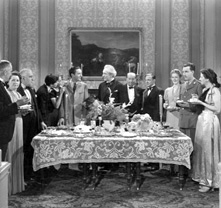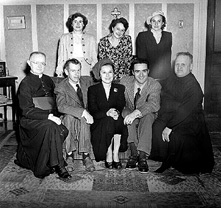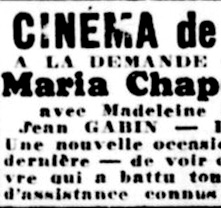Quebec’s French Cousins in its Cinema
-

Production still for the film Le père Chopin (Fedor Ozep, 1945).
Source : Cinémathèque québécoise 1995.2188.PH.08
-

Poster for the film Maria Chapdelaine (Julien Duvivier, 1934).
Source : Cinémathèque québécoise, 1988.2299.AF
-

The cast of the radio program Le ciel par-dessus les toits starring Guy Maufette, seen here for the purposes of the photograph with Aloysius Vachet (lower right) and Lionel Groulx (lower left).
Source : Cinémathèque québécoise, 2001.0661.PH
-

La Patrie, 23 January, 1935, p.13
Source : Bibliothèque et Archives nationale du Québec
Quebec’s French “cousins” made an important contribution to the first two decades of its film industry, from 1930 to 1953.
The French in distribution
In July 1930, France’s principal film producers, who saw in Quebec a natural outlet for their films, entrusted their compatriot Robert Hurel with the task of representing them in Canada. A former employee of Paramount in France, Hurel knew the ins and outs of distribution and was somewhat familiar with Quebec, having visited there in 1929. In August 1930, he established the Compagnie cinématographique canadienne, known as France-Film, which in a short time became the major exhibition and distribution company in Quebec for French films and films in French. France-Film’s leading position was maintained until the 1950s. In 1934, however, it was taken over by French-Canadian businessmen.
A Frenchman shoots Maria Chapdelaine in Quebec
That same year, 1934, while French cinema was enjoying great popularity in Quebec, Julien Duvivier arrived in Péribonka to shoot the first adaptation of the novel Maria Chapdelaine, written twenty years earlier by Louis Hémon, a Frenchman who had come to Quebec to get to know the land and its people. Two French movie stars, Jean Gabin and Madeleine Robinson, played the lead roles in the film. The novel was already known internationally and the film was released to great success by France-Film in 1935. Maria Chapdelaine would be adapted twice more, by Marc Allégret in 1950 and Gilles Carle in 1984.
In 1939, Aloysius Vachet, a French priest who owned a small film production company called Fiat Films, directed Notre Dame de la Mouise, in part with Quebec capital invested by J.A. DeSève. This was the first Franco-Quebec co-production. The two men’s work together was interrupted by the Second World War, but resumed in 1946 when Vachet moved to Quebec and lived there for five years, becoming one of the major figures behind Renaissance Films.
Films from France and Quebec on movie screens
In early 1944, Charles Philipp, a man with many years of production experience in France, moved to Quebec and founded Renaissance Films with a view to producing feature-length films for commercial release. He already had a script, called Le père Chopin, by Bella Daniel (a pseudonym of Philipp himself, made up of the first names of his wife and son). Shooting took place that summer with Fedor Ozep directing. Ozep was of Russian origin and had lived for many years in France. The film premiered on 19 April 1945; it was a gentle story of the reuniting of two French brothers who were separated in childhood, one a music teacher in the remote Quebec countryside and the other a rich industrialist living in Montreal. Almost all the film’s leading roles were played by French actors (Marcel Charbier, François Rozet, Madeleine Ozeray), but several young Quebec actors, including Guy Mauffette, Pierre Dagenais, Ginette Letondal and Oliva Légaré, also made their mark in it. Le père Chopin met with instant success and created bright possibilities for the future.
Cousins who know how to lend a hand
After Le père Chopin, a period of abundance began in Quebec cinema. The contribution of French personalities was significant. Some were already in Quebec, such as Paul Gury, a theatre author and stage director who switched over to cinema long enough to make a few films; and the young actress Janine Sutto, who had already made her mark on the stage. Two years after Le père Chopin, Ozep shot La forteresse for Québec Productions. There then came directors such as René Delacroix (a Catholic and friend of Vachet), actors such as René Dary, and technicians such as Claude Perrier, José Ména and Anton Van de Water. In front of or behind the camera, they all brought experience that the young Québécois helping them were quick to make use of. Several of them stayed in Quebec and pursued their careers there.